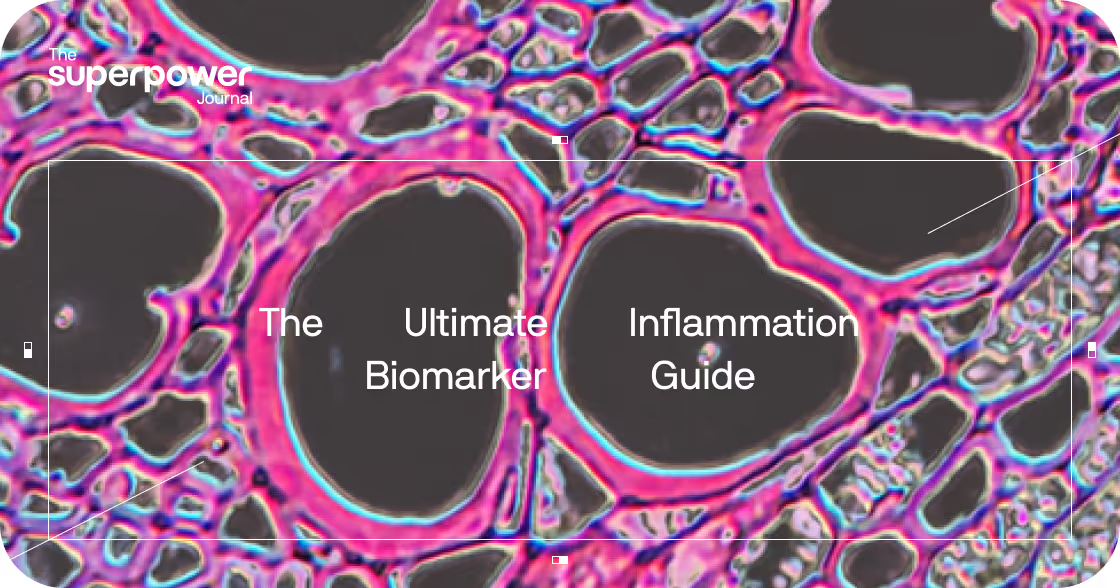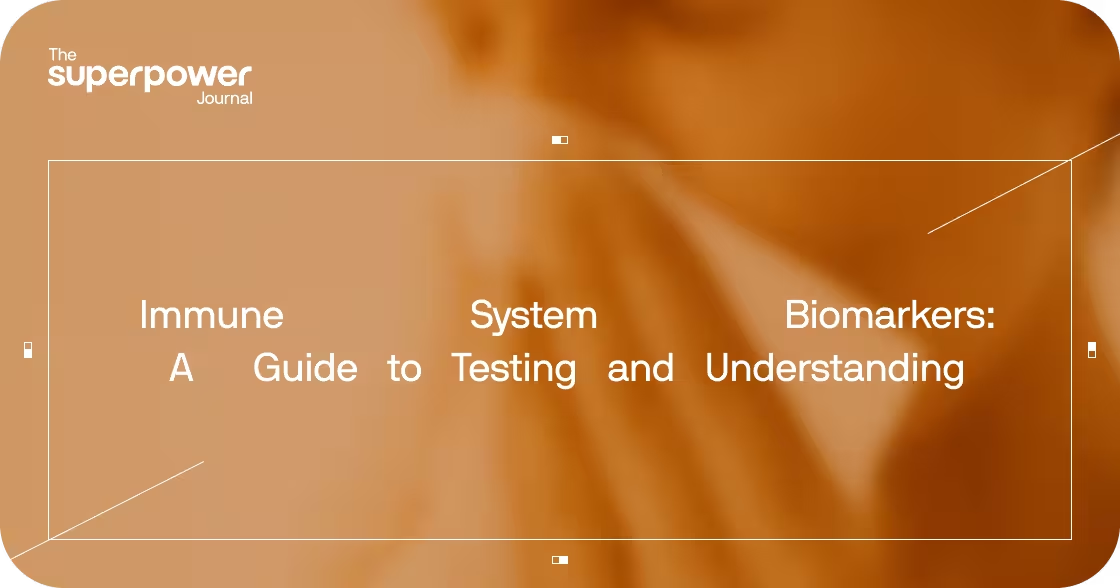Chronic, low-grade inflammation, sometimes called inflammaging, is linked to major diseases such as heart disease, diabetes, arthritis, and cognitive decline. Unlike the short bursts of inflammation that heal injuries, this persistent state can drive silent tissue changes and increase risk years before symptoms appear.
Inflammation biomarkers are blood-based measures — such as CRP, ESR, and immune cell ratios — that estimate the body’s inflammatory activity. They capture signals from the immune system and liver, and indirectly reflect stress on tissues and blood vessels. Interpreted together, they provide an early indication of whether the body is in balance or carrying an inflammatory burden. This guide explains the key biomarkers, how they are interpreted, and why tracking them is important for long-term health and vitality.
Why Inflammation Matters
Your body relies on inflammation as a defense and repair mechanism. When you cut your finger, immune cells rush in to clear debris and begin healing. The problem comes when this response fails to switch off. Persistent, low-grade inflammation can quietly disrupt metabolic, cardiovascular, and immune pathways.
In the United States, six in ten adults live with at least one chronic disease ¹ ². Many of these conditions, such as cardiovascular disease, type 2 diabetes, and arthritis, are closely associated with chronic inflammation. In this way, inflammation is rarely a short-lived event; it often becomes a silent companion to long-term illness.
How the Body's Systems Interact in Inflammation
Inflammation is never confined to a single organ. Chemical signals move through the bloodstream, immune cells, and hormones, linking many systems together ³. The immune system mobilizes white blood cells to respond to injury or infection. The liver produces proteins such as C-reactive protein (CRP) that rise with inflammation, while albumin levels often fall. The bone marrow adjusts production of platelets and immune cells. Hormones — including cortisol, sex steroids, and adrenal androgens — modulate inflammatory pathways, influencing how resilient or vulnerable the body may be ⁴ ⁵. Blood vessels are constantly exposed to these signals, which can affect vessel stiffness and lipid transport over time.
Because these systems are interconnected, strain in one area can alter or burden the others. Over time, this network effect creates imbalance, and it is precisely these patterns that inflammatory biomarkers help to detect.
Not All Inflammation Markers Behave the Same
Inflammatory biomarkers vary in what they reflect ⁶. C-reactive protein (CRP) rises and falls quickly with inflammation, making it a reliable short-term marker of systemic stress. Erythrocyte sedimentation rate (ESR) changes more slowly, so it can stay elevated even after inflammation has begun to resolve.
Ferritin is primarily an iron-storage protein, but it also rises as part of the acute-phase response. That means high ferritin may reflect either excess iron or inflammation, and it must be interpreted alongside CRP and other markers. Serum iron often falls during inflammation, because the body sequesters iron to limit microbial growth.
White blood cell (WBC) counts add another layer: neutrophils often rise with acute infection or stress, while lymphocytes may fall during chronic inflammation or illness. Other shifts — such as increased eosinophils in allergies or parasites, or elevated monocytes in chronic immune activation — provide further clues.
Because each test reflects a different facet of immune and metabolic activity, no single marker tells the whole story. Considering CRP, ESR, ferritin, iron, and WBC patterns together gives a clearer picture of whether the body is facing acute infection, chronic inflammatory stress, or an underlying imbalance.
Key Inflammation Biomarkers
These tests are widely used in clinical practice and have clear guideline-based interpretation. They form the backbone of inflammation assessment.
High-Sensitivity C-Reactive Protein (hs-CRP)
A liver protein that rises within hours of infection, injury, or stress, and falls quickly as inflammation resolves. Its speed and sensitivity make it useful for detecting subtle inflammation and assessing cardiovascular risk. ⁷
Erythrocyte Sedimentation Rate (ESR)
Measures how fast red blood cells settle in a tube, influenced by fibrinogen and other plasma proteins. It changes more slowly than CRP, making it less specific but more reflective of long-term inflammation. ⁸
Ferritin
The body’s main iron-storage protein, but also an “acute-phase reactant.” High ferritin may signal iron overload, inflammation, or both. Interpretation requires context from CRP and iron studies. ⁹
White Blood Cell (WBC) Count
A direct readout of immune activity. Neutrophils rise in acute infection, lymphocytes may fall in chronic illness, eosinophils rise with allergies or parasites, and monocytes increase with long-term immune stress. Patterns give clues to the underlying cause.
Emerging Research-Based Ratios
Combine multiple blood measures into composite scores. They are still research-based and not standardized for routine screening, but they have shown consistent associations with outcomes in areas like cancer, cardiovascular disease, and kidney health. Their strength is in adding depth: they highlight how inflammation interacts with immunity, nutrition, and metabolism in ways single markers cannot.
- Ferritin / CRP: Helps distinguish whether high ferritin reflects iron overload or inflammation. ⁹
- CRP / Albumin Ratio (CAR): Balances a positive acute-phase protein (CRP) against a negative one (albumin), linking inflammation with nutritional status. ¹⁰
- Platelet / Lymphocyte Ratio (PLR): Reflects both clotting potential and immune balance. ¹¹
- Monocyte / HDL Ratio (MHR): Compares pro-inflammatory immune cells with protective HDL cholesterol. ¹²
- Systemic Immune-Inflammation Index (SII): Uses platelets, neutrophils, and lymphocytes to represent immune activation. ¹³
- Systemic Inflammation Response Index (SIRI): Combines neutrophils, monocytes, and lymphocytes for another view of systemic inflammation. ¹⁴
- Ferritin / Albumin Ratio (FAR): Pairs iron storage with protein reserves; useful in chronic disease and nutrition research. ¹⁵
- CRP / DHEA-S Ratio: Explores how adrenal androgens may buffer inflammatory stress. ¹⁶
- Testosterone / CRP Ratio: Investigates the balance between anabolic hormones and inflammation. ¹⁷
Normal Versus Optimal
Laboratory “normal ranges” are based on statistical averages of the population. They show where most people fall, not necessarily what is healthiest. With the majority of adults living with at least one chronic condition ¹⁸, “normal” often reflects a population already affected by disease.
Optimal ranges are narrower. They represent the levels where risk of disease is lowest and the body functions best. This is the difference between acceptable and ideal: you can be “in range” yet still experience fatigue, brain fog, or other subtle signs of imbalance.
As evidence grows linking low-grade, chronic inflammation to cardiovascular, metabolic, and neurodegenerative disease, aiming for optimal—not just normal—has become key for prevention and long-term health.
Inflammation Biomarkers and Longevity
One of the strongest predictors of healthy aging is the burden of low-grade, chronic inflammation. This hidden process doesn’t simply appear alongside aging. It actively drives it, accelerating DNA damage, arterial stiffening, and disruption of hormonal and immune balance ¹⁹.
Research consistently shows that people with lower hs-CRP, stable immune cell ratios, and balanced hormone-inflammation interactions maintain better mobility, sharper cognition, and lower disease risk as they age ²⁰. The challenge is that inflammation often progresses silently for years. Many only discover an inflammatory condition once damage is advanced, even though biomarkers could have revealed early warning signs long before symptoms appeared.
How to Improve Inflammation Biomarker Levels
1. Nutrition
Dietary patterns matter more than isolated foods. Diets rich in vegetables, fruits, whole grains, and healthy fats consistently lower inflammatory markers ²¹ ²². For example, increasing dark leafy greens has been shown to reduce CRP by up to 1 mg/L within a week ²¹ ²². The effect comes from antioxidants and phytonutrients that neutralize reactive oxygen species and calm NF-κB–driven inflammatory signaling ²² ²³.
Omega-3 fatty acids (EPA and DHA) provide another well-documented benefit. Meta-analyses show meaningful reductions in CRP, TNF-α, and IL-6, especially in people with higher baseline inflammation ²⁴ ²⁵ ²⁶. Doses of ~1–2 grams per day are most often effective, with EPA sometimes showing stronger results ²⁴ ²⁶.
Micronutrient adequacy also plays a role. Better overall vitamin and mineral intake is linked to lower CRP, and deficiencies in magnesium, vitamin C, and vitamin E are particularly associated with higher inflammatory levels ²¹ ²².
2. Exercise
Sustained exercise has well-documented anti-inflammatory effects, especially when continued for 12 weeks or more ²⁷ ²⁸ ²⁹. Moderate-intensity activity appears most effective, lowering CRP, IL-6, and TNF-α more consistently than very high-intensity training ²⁷ ²⁹.
The mechanism goes beyond energy use: contracting skeletal muscle functions as an endocrine organ, releasing myokines that dampen systemic inflammation ²⁸. Even a single workout triggers short-term cytokine shifts that activate anti-inflammatory pathways within hours ²⁸ ²⁹.
Different exercise types influence markers differently. Aerobic training is particularly effective at reducing CRP, while combining resistance and aerobic training produces the greatest reduction in IL-6 ²⁷ ²⁹. It’s worth noting that very prolonged or extreme endurance training (such as long-distance running or repeated high-intensity sessions without recovery) can temporarily increase inflammation and oxidative stress ²⁸. The strongest long-term benefits come from moderate-intensity, balanced programs sustained over time ²⁷ ²⁹.
3. Sleep
Sleep is one of the body’s strongest regulators of inflammation. During deep sleep, cortisol and cytokine rhythms align to boost natural killer cell activity and prepare immune defenses for the next day ³⁰. When sleep is disrupted, these rhythms shift: IL-6 peaks at the wrong time, creating persistently higher inflammatory levels ³¹.
Even short-term sleep loss can have dramatic effects. Just one night of deprivation can raise inflammatory markers to levels seen in acute illness ³². Chronic disturbance makes matters worse, blunting cortisol’s anti-inflammatory action and keeping CRP, IL-6, and TNF-α elevated ³⁰ ³¹.
It’s not just about hours in bed. Quality is critical. Fragmented or restless sleep can drive inflammation even when total duration looks “normal.” Poor sleep also dampens recovery, slowing repair of muscle, immune, and metabolic systems that rely on restorative sleep to recalibrate ³⁰ ³¹.
4. Stress Management
Psychological stress leaves a biological imprint. It disrupts normal cortisol rhythms, flattening the day–night cycle and contributing to higher CRP, IL-6, fibrinogen, and adhesion molecules ³³ ³⁴.
Over time, this pattern builds what’s known as allostatic load: the body’s stress systems stay switched on, glucocorticoid receptors lose sensitivity, and cortisol can no longer turn off inflammation effectively ³³. The result is a feed-forward cycle: stress sustains inflammation, and inflammation makes the body less resilient to stress ³³ ³⁴.
The good news is that these effects are reversible. Practices that restore healthy cortisol rhythms, such as meditation, consistent physical activity, and social connection, have been shown to lower inflammatory markers within weeks to months ³³ ³⁴.
Even small changes matter: maintaining regular sleep-wake timing, taking short breaks for breathing exercises, or spending time outdoors can all help reset stress physiology and reduce the inflammatory burden ³³ ³⁴.
5. Targeted Supplementation
Supplements can support inflammation control, particularly when used to correct deficiencies or reinforce dietary gaps. The evidence is strongest for:
- Omega-3 fatty acids (EPA and DHA): Among the most validated interventions, consistently lowering CRP, IL-6, and TNF-α, especially in those with elevated baseline inflammation. EPA-rich forms show the greatest benefit ²⁴ ²⁵ ²⁶.
- Vitamin D: Low levels are linked with higher CRP and impaired immune regulation; correcting deficiency can reduce inflammatory activity, particularly when combined with magnesium, which is required for vitamin D metabolism ³⁵.
- Curcumin and polyphenols: Found in turmeric, green tea, berries, and other plants, these compounds reduce oxidative stress and modulate NF-κB pathways; food-based intake provides steady background support ²² ²³.
- Antioxidants (vitamin C, vitamin E, selenium, CoQ10): These nutrients help neutralize free radicals and reduce oxidative stress that fuels inflammation, with clearest benefits in individuals with low baseline status ²¹ ²².
Other options with supportive evidence include zinc (immune balance), N-acetylcysteine (NAC) (precursor to glutathione, an intracellular antioxidant), and probiotics (gut–immune interaction) ²² ³⁶.
Actionable steps:
- Test for vitamin D, zinc, and magnesium status to guide targeted use ³⁵.
- Ensure regular omega-3 intake through fatty fish or algae-based supplements ²⁴ ²⁵ ²⁶.
- Incorporate polyphenol-rich foods daily, and consider curcumin if inflammation is elevated ²² ²³.
- Use supplements to reinforce—not replace—nutrition, sleep, and stress management ²¹ ²² ³⁵.
6. Inflammation Pattern Recognition
No single biomarker gives the full picture of inflammation. What matters most is the pattern across multiple markers and how they change over time ²². For example, elevated CRP with normal albumin may point to a short-term trigger such as infection or acute stress, while high CRP combined with low albumin often reflects a heavier, chronic burden on the body ²².
Tracking markers together — CRP, ESR, ferritin, and white blood cell patterns — provides a more reliable signal than any one test alone ²². Even derived ratios (like CRP/albumin or platelet/lymphocyte) can highlight shifts earlier than absolute values, though these remain primarily research tools rather than clinical standards ²².
The key is integration: nutrition, sleep, exercise, stress management, and targeted supplementation work best in combination. When biomarker patterns improve together, it suggests the body is not just suppressing inflammation temporarily but restoring balance across multiple systems ²¹ ²².
Why Testing Inflammation Biomarkers Is Critical
Inflammation is often silent. Unlike pain or fever, low-grade inflammatory activity can persist for years without any obvious symptoms, yet it steadily increases risk for cardiovascular disease, diabetes, arthritis, and even cognitive decline ²². Testing is especially valuable if you have a family history of cardiovascular, autoimmune, or metabolic disease; experience unexplained fatigue, brain fog, or slower recovery; are over 40; or train intensely as an athlete, where overexertion can temporarily raise inflammatory load ²².
By tracking markers such as hs-CRP, ESR, ferritin, and white blood cell patterns, you gain a clearer picture of systemic stress. This shifts health from reactive disease treatment to proactive prevention and resilience-building ²².
Building a Healthier Future With Superpower
Inflammation biomarkers are not just numbers. They are windows into how your body is aging, adapting, and responding to hidden stress. By tracking these markers, you shift from reacting to disease toward actively building health.
At Superpower, we compile a comprehensive single panel measuring over 100 biomarkers, including those covered here. This empowers you to see your entire health landscape at once, moving beyond averages to your true optimal. With this insight, you can act early, prevent disease, and extend not just your life, but also your health-span.
Ready to test your biomarkers? Join Superpower today to access advanced biomarker testing with over 100 lab tests.
- National Center for Chronic Disease Prevention and Health Promotion. Trends in Multiple Chronic Conditions Among US Adults. CDC. 2025.
- World Health Organization. Chronic inflammatory diseases are the most significant cause of death in the world. StatPearls. 2023.
- Furman D, Campisi J, Verdin E, et al. Chronic inflammation in the etiology of disease across the life span. Nature Medicine. 2019.
- Bianchi VE. The anti-inflammatory effects of testosterone. Journal of the Endocrine Society. 2019.
- Phillips AC, Carroll D, Gale CR, et al. Cortisol, DHEAS and cardiovascular disease risk. Psychoneuroendocrinology. 2010.
- Sproston NR, Ashworth JJ. Role of C-Reactive Protein at Sites of Inflammation and Infection. Frontiers in Immunology. 2018.
- Ridker PM. Clinical application of C-reactive protein for cardiovascular disease detection and prevention. Circulation. 2003.
- International Committee for Standardization in Haematology. Reference method for the erythrocyte sedimentation rate (ESR) test on human blood. British Journal of Haematology. 1993.
- Urbanski G, Chabrun F, Lavigne C, et al. Serum ferritin/C-reactive protein ratio is a simple and effective biomarker for diagnosing iron deficiency in the context of systemic inflammation. QJM: An International Journal of Medicine. 2024.
- Ranzani OT, Zampieri FG, Forte DN, et al. C-Reactive Protein/Albumin Ratio Predicts 90-Day Mortality of Septic Patients. PLoS One. 2013.
- Templeton AJ, McNamara MG, Šeruga B, et al. Prognostic role of platelet to lymphocyte ratio in solid tumors: a systematic review and meta-analysis. Cancer Epidemiology, Biomarkers & Prevention. 2014.
- Canpolat U, Çetin EH, Cetin S, et al. Association of Monocyte-to-HDL Cholesterol Ratio with Slow Coronary Flow is Linked to Systemic Inflammation. Clinical and Applied Thrombosis/Hemostasis. 2016.
- Huang Z, Fu Z, Huang W, Huang K. Prognostic value of neutrophil-to-lymphocyte ratio in sepsis: A meta-analysis. American Journal of Emergency Medicine. 2020.
- Qi Q, Zhuang L, Shen Y, et al. A novel systemic inflammation response index (SIRI) for predicting the survival of patients with pancreatic adenocarcinoma after chemotherapy. Cancer. 2016.
- Öztürk Taşkin G, Aydemir S, Şahin E, et al. Ferritin to albumin ratio: a simple and effective marker for predicting mortality in COVID-19 patients. American Journal of Emergency Medicine. 2021.
- Maggio M, Guralnik JM, Longo DL, Ferrucci L. Interleukin-6 in aging and chronic disease: a magnificent pathway. Journal of Gerontology. 2006.
- Bianchi VE. Low testosterone as a risk factor for cardiovascular mortality in men. Andrology. 2020.
- Watson KB, Wiltz JL, Nhim K, Kaufmann RB, Thomas CW, Greenlund KJ. Trends in Multiple Chronic Conditions Among US Adults, By Life Stage, Behavioral Risk Factor Surveillance System, 2013–2023. Prev Chronic Dis 2025;22:240539.
- Franceschi C, Campisi J. Chronic inflammation (inflammaging) and its potential contribution to age-associated diseases. Journal of Gerontology. 2014.
- Singh T, Newman AB. Inflammatory markers in population studies of aging. Ageing Research Reviews. 2011.
- Effects of Dietary Patterns on Biomarkers of Inflammation and Immune Responses: a systematic review and meta-analysis of randomized controlled trials. Advances in Nutrition. 2022.
- Dietary Patterns Associated With Anti-inflammatory Effects: an umbrella review of systematic reviews and meta-analyses. Nutrition Reviews. 2025.
- Dietary patterns and biomarkers of oxidative stress and inflammation: systematic synthesis. Nutrition and Healthy Aging. 2021.
- Omega-3 fatty acids effects on inflammatory biomarkers and lipid profiles: systematic review and meta-analysis. Scientific Reports. 2019.
- Efficacy of omega-3 fatty acids supplementation on inflammatory markers: systematic review and meta-analysis. 2022.
- Inflammation as a predictive biomarker for response to omega-3 fatty acid supplementation: review and meta-analytic synthesis. Journal of the American College of Nutrition. 2015.
- Effects of different exercise modalities on inflammatory markers in obese and overweight individuals: meta-analysis. Frontiers in Physiology. 2024.
- Long-term exercise training and inflammatory biomarkers in healthy adults: review/meta-analytic synthesis. Frontiers in Psychology. 2023.
- The effect of physical interventions in older adults on inflammatory biomarkers: umbrella review. Innovation in Aging. 2025.
- The Sleep-Immune Crosstalk in Health and Disease. Physiological Reviews. 2019.
- Role of sleep deprivation in immune-related disease risk and outcomes. Communications Biology. 2021.
- Effects of Experimental Sleep Deprivation on Peripheral Inflammation: review. Journal of Sleep Research. 2019.
- Physiological biomarkers of chronic stress: a systematic review. Neuroscience & Biobehavioral Reviews. 2004.
- Psychological measures of stress and biomarkers of inflammation: a systematic review. Scientific Reports. 2023.
- The effects of magnesium and vitamin D/E co-supplementation on inflammatory biomarkers: systematic review and meta-analysis. Frontiers in Nutrition. 2025.
- Food-based indexes and their association with dietary inflammation: comprehensive review of diet quality indexes and inflammatory biomarkers. 2025.




.avif)
.png)






.svg)


